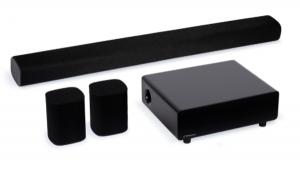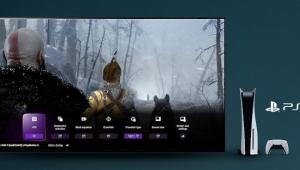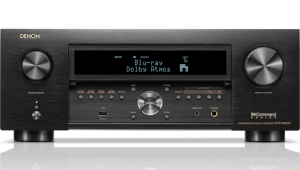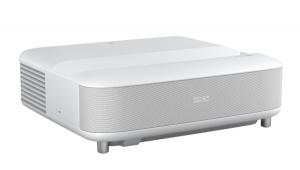First Listen: Audyssey DSX

Denon's AVR-4810CI A/V receiver is the first product that exploits the full 11.1-channel capability of Audyssey DSX processing. Here are our initial impressions:
Based on posts I've seen on various websites, I think home theater enthusiasts have reached the point of channel fatigue. Proposals to add more speakers to our current 7.1-channel systems meet with as much enthusiasm as tax increases. So if someone wants us to add more speakers, they'd better make a solid case.
Among enthusiasts and reviewers, Dolby doesn't seem to have made a particularly compelling case for its 7.1-plus technology, Pro Logic IIz, which adds two height speakers to a 5.1 or 7.1 system. When I evaluated PLIIz a few months ago, I heard a subtle enhancement at best; one reviewer I know and respect heard nothing at all.
Audyssey Labs'DSX technology promised to upstage PLIIz by adding two width speakers in addition to PLIIz's height speakers. However, the first DSX-equipped receivers didn't deliver 100 percent of what Audyssey had promised - they could produce height or width channels, but not both at the same time.
The first product that can deliver all of the 11.1 channels of which DSX is capable is Denon's AVR-4801CI, a $2,999 piece that's second-from-top in Denon's receiver line. I begged to take a quick listen to the AVR-4810CI before it went to Sound + Vision ace receiver reviewer Daniel Kumin, so I could find out if DSX makes a better case for 7.1-plus sound.
THE SETUP
I used the same speakers for my DSX evaluation that I used to audition PLIIz: a system built around Sunfire's CRM-2 speakers, with the CRM-2C for the center channel and the CRM-2BIP for side surround speakers.
 After consulting diagrams provided in the receiver's manual and on Audyssey's website, I placed all the speakers as recommended for DSX. The height speakers (the blue shapes in the accompanying drawing) went on shelves 45 inches above the front left and right speakers (the angled-in green shapes). The width speakers (purple shapes) sat on stands at the same height as the front left and right speakers. The surround speakers (red shapes) were mounted on 5-foot-high stands placed along the walls just behind my couch. The subwoofer (orange shape) sat in its usual place between the center and front right speakers, under my projection screen.
After consulting diagrams provided in the receiver's manual and on Audyssey's website, I placed all the speakers as recommended for DSX. The height speakers (the blue shapes in the accompanying drawing) went on shelves 45 inches above the front left and right speakers (the angled-in green shapes). The width speakers (purple shapes) sat on stands at the same height as the front left and right speakers. The surround speakers (red shapes) were mounted on 5-foot-high stands placed along the walls just behind my couch. The subwoofer (orange shape) sat in its usual place between the center and front right speakers, under my projection screen.
In order to match the setup I used for PLIIz, I used just two surround speakers for most of my listening, but I did listen to a few clips with a couple of KEF iQ10 minispeakers added as rear surrounds. I had to add an external stereo amp to power these, because the AVR-4810CI offers "only" nine channels of amplification. While the rear surround speakers added a bit more wraparound effect behind me, I didn't consider them a big improvement. They'd be useful in a large home theater with two or three rows of seats, though.

The AVR-4810CI carries the full package of Audyssey technologies: MultEQ, Dynamic EQ, and Dynamic Volume. To assure that I got the best possible DSX presentation, I used Audyssey's automatic setup procedure. However, I first I had to tell the receiver what speaker configuration I was using. This procedure proved complicated enough that I had to consult the manual, something I usually don't have to do with receivers. Fortunately, an on-screen graphic showed the speaker configuration I had selected, assuring me that I'd made the correct choices. After letting the auto setup function do its thing, I was ready.
Or so I thought. Even after several minutes of fumbling with the remote and browsing the on-screen menus, I was unable to turn DSX processing on. It took several more minutes of flipping through the lengthy manual to discover that the DSX processing is activated and deactivated through a button on the remote's touchscreen. Denon labeled this button SPKR. (They'll pay for the confusion they caused me - at the next Denon press event I'm going to wear a nametag that says "Jeff.")
THE SOUND
I started my DSX evaluation with the movie that so thrilled me when I heard it in PLIIz: Death Race, a post-apocalyptic automotive action flick starring the indestructible and cooly accented Jason Statham. This isn't some character-driven movie where people talk to each other about stuff. It's mostly Road Warrior-type patchwork muscle cars outfitted with whirring miniguns, napalm canisters, and hot babes, battling each other to the strains of a heavy-metal soundtrack.
Unlike PLIIz, the effect DSX produced was in no way subtle. The contributions of the height and width speakers were readily apparent. In fact, they seemed to be playing only a few decibels lower than the front left, center, and right speakers.
I particularly noticed the contribution of the width speakers, which greatly enhanced the realism of "fly-by" effects, such as when parts of cars went whizzing from the front speakers to the surrounds. There's no question the sound was more involving; it seemed almost as if I were strapped to a chair in a special audio simulation test lab rather than sitting on my couch in a normal home theater. While PLIIz delivers an understated enhancement, DSX pushes the added surround effect much further. It mostly makes sonic sense, though. DSX's effect seems to be designed more for greater realism rather than to wow you in the way reverb-soaked digital surround modes included in some receivers do.
However, one could also make the case that the sound with DSX is more confusing. With audio cues spread among more speakers-and with what appeared to be some subtle phase manipulation added to enhance the surround effect - the sound was less focused. In the fast-moving scenes from Death Race, audio cues are added to help your brain comprehend the frantic on-screen action. But with less sonic focus, the cues sometimes seemed less effective to me.
I noticed a similar effect when I played the beginning of the brontosaurus stampede from the Peter Jackson-directed King Kong. As rocks begin falling from the canyon walls, DSX produced an effect that could simultaneously be considered more realistic (i.e., more ambient) and less impactful (i.e., less focused). I had trouble deciding which sound I prefer - although I suspect that the bigger the home theater, the more I'd appreciate DSX.

Let me give a pat on the back to Denon here: It's simple to turn DSX on and off once you figure out which button to use, and there's a bright blue DSX indicator on the front of the receiver that makes it easy to see which mode you're in. So if you don't like the effect DSX is having on whatever you're listening to, you can turn it off immediately rather than having to wade through on-screen menus.
Ratatouille - a movie that Dolby uses to demo PLIIz - proved revealing of DSX's strengths and weaknesses. The opening rainstorm scene really makes the case for height speakers. Hear it in PLIIz and you'll never want to go back to 5.1. Hear it in DSX and you'll never want to go back to PLIIz. I guarantee you have never heard a surround effect so convincing. You almost want to wipe the raindrops off your face.
However, DSX's effect on the dialogue that immediately follows was weird. It didn't impact dialogue that was "hard center"-i.e., coming entirely from the center speaker. However, the voiceover that begins the movie is spread into the other speakers a bit to give it more of a "voice of God" effect. DSX gets hold of this and blows it all out of proportion. The voiceover becomes unfocused and phasey-sounding, almost as if it has a bit of chorus effect added from a guitar player's stomp box. While this worked great on Andy Summers' guitar track in the Police's "Don't Stand So Close to Me," I didn't dig it on a movie voiceover.
I began with Death Race, King Kong, and Ratatouille because I knew they'd let me dissect DSX's operation. But with most movies, its effects were subtler and almost never objectionable. I expected DSX to have an extreme effect on such surround-sound classics as The Fifth Element and Star Wars, Episode II: Attack of the Clones, but it didn't. With both movies, DSX didn't call attention to itself, it simply added extra ambience and made the surround-sound effect more seamless.
Music DVDs sometimes gave me the weird, disembodied effect I noticed in Ratatouille, mainly because many 5.1 music mixes spread the vocals among the front left, center, and right speakers. I even noticed this problem when I played James Taylor's Live at the Beacon Theatre - a mix which puts almost all of the singer's sweet voice in the center speaker, with just a touch in the left and right front speakers. Even this center-heavy mix became less focused and intimate when heard with DSX applied.
- Log in or register to post comments




















































